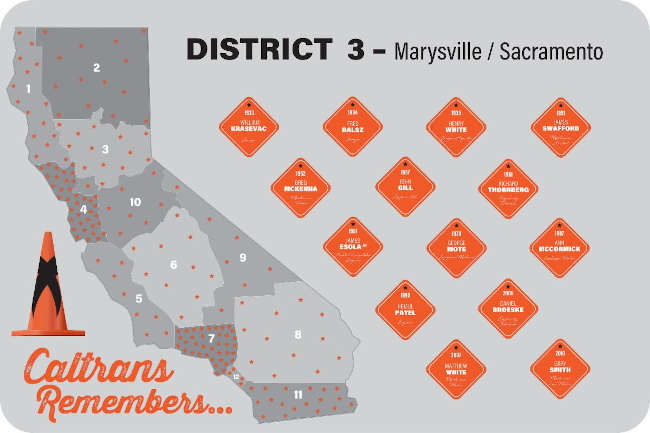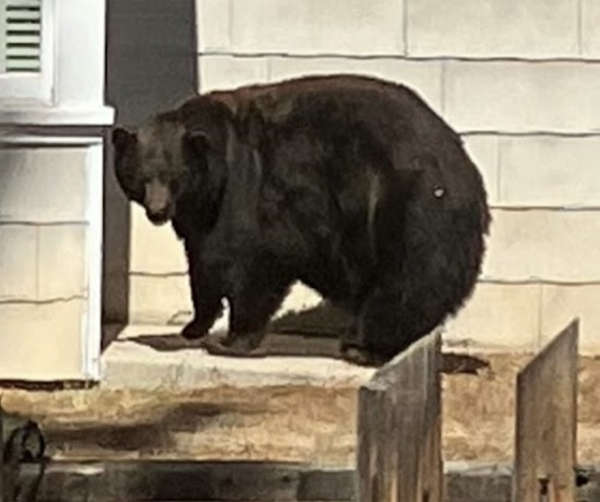- CALTRANS
- Posted On
Caltrans honors fallen highway workers with memorial signs in state rest areas

Caltrans District 3 on Tuesday announced that it will install memorial signs in roadside rest areas along the California state highway system to honor its 14 workers who died in the line of duty and to encourage travelers to drive responsibly.
The memorial signs were designed, manufactured and will be installed by Caltrans workers to recognize the 191 highway workers who have been killed on the job statewide since 1921.
Every year, Caltrans employees, family members of fallen workers, and community members throughout California gather to honor these workers and to promote safe driving campaigns.
“Safety is Caltrans’ top priority,” said Caltrans Director Tony Tavares. “Lives are literally at stake every day. We hold a sacred duty to remember all the people who have lost their lives working with us, and I implore all Californians to please slow down and move over in every work zone, every time. A life may depend on it.”
Since 1923, District 3 has lost 14 employees who were performing their normal duties on the job.
“We will never forget our fallen employees who worked diligently to ensure our roadways were safe for the traveling public,” said District 3 Director Amarjeet S. Benipal. “The tremendous sacrifices by these public servants remind us of the enormous loss to their family, friends and Caltrans.”
District 3’s last on-the-job fatality occurred in 2010 after Chico Maintenance Leadworker Gary Smith, 57, was struck and killed by a motorist while performing traffic control for a detour around an earlier fatal crash. The driver of the vehicle that struck Smith later pleaded guilty to gross vehicular manslaughter while intoxicated and sentenced to prison.
Three years earlier, 35-year-old Highway Maintenance worker Matthew White was struck and killed by a vehicle exiting at the Interstate 5 Southbound Elk Grove Boulevard off-ramp during the morning hours. White was a second-generation Caltrans employee.
On Monday, Caltrans crews installed the first District 3 memorial signs at the west- and eastbound Interstate 80 Gold Run rest areas. The signs also will go up at the I-80 Donner Summit and Interstate 5 Elkhorn, Dunnigan, Maxwell and Willow rest areas.
District 3 maintains more than 4,385 lanes miles of state highway in 11 Sacramento Valley and Northern Sierra counties. From 2013 to 2022, 1,424 people lost their lives on the region’s state highways stretching from Butte County to Sacramento County and from Colusa County to EI Dorado County. Of that number, 39 deaths resulted from 38 vehicle crashes in active construction zones.

With the passage of the federal Infrastructure Investment and Jobs of 2021 as well as Senate Bill 1, the Road Repair and Accountability Act of 2017, Caltrans and local agencies now have significant additional funds to repair and maintain California’s transportation system. The additional funding has increased the number of Caltrans employees and contractors working on the state highway system, highlighting the importance for drivers to stay vigilant and aware.
According to the U.S. Bureau of Labor Statistics, highway construction and maintenance work is one of the most hazardous occupations in the United States. In 2021, more than 9,500 work zone collisions occurred on California highways, resulting in an estimated 2,971 injuries and 73 fatalities. Nationally, drivers and passengers account for 85 percent of people who are killed in work zones.
In 2022, Caltrans announced a new Director’s Policy on Road Safety, which commits the department to the Safe System approach and reaffirms the vision of reaching zero fatalities and serious injuries on state highways by 2050. This policy takes steps to further a shift that began in 2020, as state transportation leaders recognized a bolder and more focused approach was necessary to combat the troubling rise in fatalities and serious injuries on California roads.
The state’s 2020-24 Strategic Highway Safety Plan — managed by Caltrans and involving more than 400 stakeholders — was updated to include the Safe System approach.
Caltrans has partnered with the California Transportation Foundation to develop two funds to benefit the families of Caltrans workers killed on the job.
The Fallen Workers Assistance and Memorial Fund helps with the initial needs a surviving family faces and the Caltrans Fallen Workers Memorial Scholarship is available to the children of these workers.
For more information or to make donations, visit the California Transportation Foundation.





 How to resolve AdBlock issue?
How to resolve AdBlock issue? 




